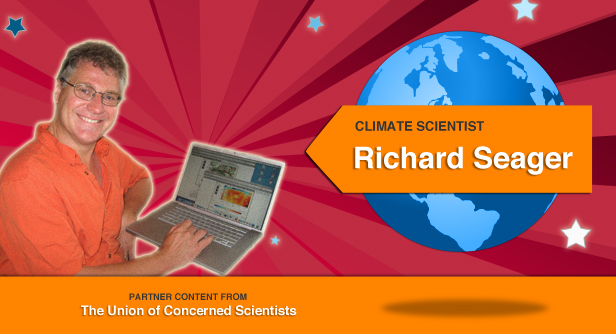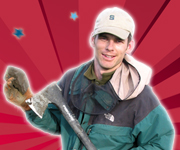If you’re one of the tens of millions of people who live in the southwestern United States, get ready for drier weather. That’s the message from Richard Seager, a climate scientist at Columbia University’s Lamont-Doherty Earth Observatory. The American Southwest, says Seager, is soon likely to experience a “permanent drought” condition on par with the Dust Bowl of the 1930s.
That rather frightening prediction is the most likely scenario for the region, given the global warming now underway. “It is a matter of simple thermodynamics,” says Seager. “The region will face a considerable increase in aridity over the coming decade.”

The Southwest is as dry as it is because the local atmospheric flow tends to export far more moisture than storms can carry into the region. This is the case in other parts of the so-called subtropics, those areas directly north and south of the equatorial tropics. But as earth’s atmosphere becomes laden with heat-trapping greenhouse gases, it will be able to retain even more moisture. That means more evaporation from lakes and rivers, more moisture loss from plants, and drier soil.
A critical player in this drying cycle is the planetary-scale circulation system known as the “Hadley cell.” This vast atmospheric system links rising air near the Equator with descending air in the subtropics, giving rise to the subtropical jet streams.
In the northern hemisphere the jet stream flows west to east across North America. Rising moist air condenses and forms thunderstorms in the tropics, but the moisture is largely lost by the time the air descends at subtropical latitudes. That’s why most of the world’s deserts are situated in the subtropics.
The Hadley cell is growing. Its expansion above a larger swath of the American Southwest, along with a shifting of the jet stream and many storms northward, is a worrisome trend, says Seager. It means there is little chance that the Southwest can avoid becoming drier in the coming decades. In fact, when Seager’s team analyzed some 49 computer projections of the region’s likely future climate, using 19 major climate models, all but three scenarios agreed: drought ahead.
Seager has been tracking changes in precipitation for nearly a quarter century. For his graduate thesis at Columbia University he used computer models to try and understand the role of sea-surface temperatures in driving precipitation patterns in the tropics and around the world.
Growing up in a working-class family in Norwich, England, Seager spent a lot of time outdoors with his family. Cycling and hiking the hills of England and Scotland sparked his interest in the physical world. It didn’t hurt his current professional interests that he grew up with “more weather than you would wish on anyone.”
One of his undergraduate tutors was the climate scientist Ann Henderson-Sellers. She had recently returned to England after working in James Hansen’s renowned climate science research center in New York. “She’s the one who suggested that I apply to graduate school in climate science in the U.S.,” says Seager. He and his brother were the first members of their family to earn college degrees.
Moving to New York for a graduate degree was a big step — and, as it turned out, a lasting one. Except for a stint as a postdoc at the University of Washington in Seattle, Seager has remained at Columbia to conduct climate research ever since.
Seager recognizes that the stakes of his drought research are high. “The prospect of a drought on par with the 1930s is a matter of serious concern,” he says. “With some two million people displaced, the Dust Bowl was probably the worst environmental disaster in the nation’s history — even counting the current oil spill in the Gulf.”
Seager is quick to add, however, that many features of the Dust Bowl are unlikely to be repeated. For one thing, he says, “we have learned an awful lot about soil conservation since the 1930s.”
As severe as the impending drought conditions now appear, Seager also emphasizes the vital mitigating role played by the Colorado River, which carries an enormous volume of water to the southwestern United States. The region, he notes, now diverts between 80 and 90 percent of that water for agricultural uses, but that could be changed.
Other regions are not as lucky. The Colorado River is barely a trickle of water by the time it reaches the border with northern Mexico, where the potential for water shortages is more immediate and more likely to lead to the displacement of people in coming years.
Seager believes that part of his job is to inform people about these climatic changes. He often briefs water managers throughout the region, including those with the California Department of Water Resources and at the U.S. Bureau of Reclamation, which manages the Colorado River.
“It’s a comparatively small part of my job, because mostly I’m focused on doing the science,” Seager says, “but it is an important part. Much of our funding comes from the National Oceanic and Atmospheric Administration (NOAA), and a reasonable condition of the grants is that we do something to make sure the information gets out.”
One common complaint is that his work is neither precise enough nor at a large enough scale to be useful to water managers. He feels their pain. “There is still so much natural variability in the weather that I cannot say with certainty what will happen in their particular neck of the woods and exactly when,” he says. But he is hard at work trying to improve his modeling of the region’s climate.
For the past several years Seager has been studying naturally occurring droughts in the American Southwest all the way back to the Middle Ages. The man-made forces that are driving today’s climate change are clear, he says. But the extent to which naturally occurring cycles might mitigate or exacerbate the impending drought remain uncertain.
“When I first went into this field, it had little perceived practical relevance,” says Seager. “The field has developed rapidly to a point where it can offer practical predictions, and the goal now is to make these as precise as we possibly can.”
Water managers in the Southwest seem to be paying attention, and even taking action. “They understand that it’s going to get drier,” says Seager. “So it is probably not a good idea for them to sit around and wait until our models get better.”
This is the 11th installment of America’s Climate Scientists: A series from the Union of Concerned Scientists. Click here to read all the climate scientist profiles.
The Union of Concerned Scientists is currently leading a campaign to elevate the voices of climate scientists and educate the public about the overwhelming scientific evidence for human-caused global warming. Learn how you can get involved at www.ucsusa.org/evidence.


